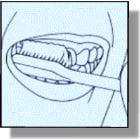Many brushing methods are known. What matters most is how effective a method removes plaque (bacteria or biofilm) from teeth.
most widely used technique (American Dental Association)

- Place your toothbrush at a 45-degree angle to the gums.
- Gently move the brush back and forth in short (tooth-wide) strokes.
- Brush the outer surfaces, the inner surfaces, and the chewing surfaces of the teeth.
- To clean the inside surfaces of the front teeth, tilt the brush vertically and make several up-and-down strokes.
Normal brushing CANNOT damage teeth or gums, click here.
How to tell when you’re done brushing: be sure to always brush until you teeth are completely smooth (see about dry-brushing, click here).
Other Methods
Other methods exist (below), they are simply not as effective at removing plaque where your brush can reach. Many of the older methods were used for anecdotal reasons, such as the notion that brushing side-to-side could damage the teeth and/or gums (it CANNOT, click here to see more about this). Another idea that served as the basis for a particular method involved the belief that brushing “stimulated” the gums. It doesn’t, but that was what was taught. It is very simple to evaluate the effectiveness of brushing by using disclosing solution to stain where plaque is present.
- Horizontal Reciprocating Motion
- horizontal scrub brushing technique
- Vibratory Motion
- Bass (sulcular) brushing technique
- Stillman’s brushing technique
- Charters brushing technique
- Vertical Sweeping Motion
- Modified Bass brushing technique
- Modified Stillman’s brushing technique
- Leonard brushing technique
- Hirchfield’s brushing technique
- Smith-Bell (physiologic) brushing technique
- Rotary Motion
- Fones brushing technique (probably one the first methods taught by the dental profession, especially in the US. Dr. Fones founded the first Dental Hygienists course in the US, and his technique was the standard method used for many years, it is often called the Circular method)
